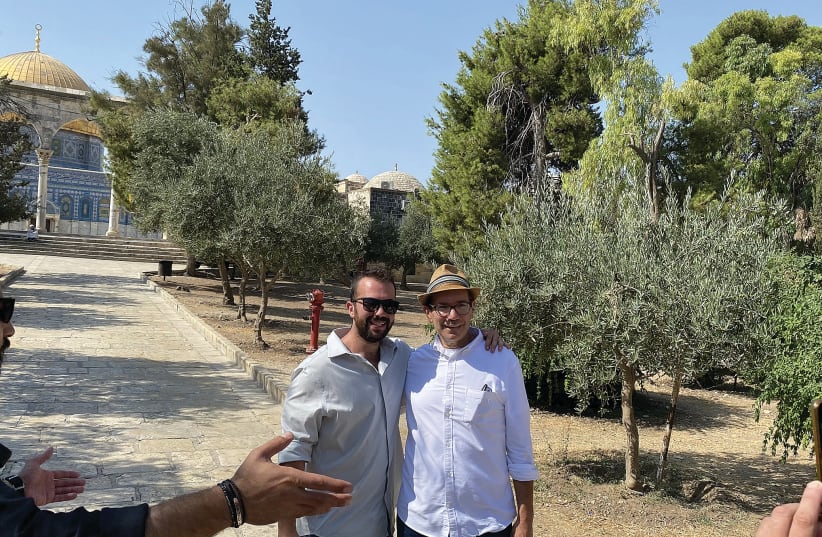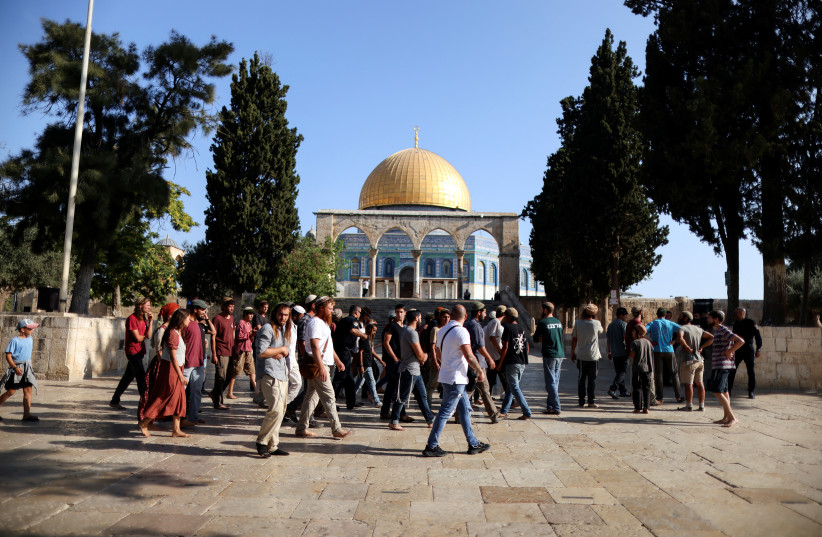This Tisha Be’av, I was one of 2,201 Jews who visited the Temple Mount – possibly the largest group of Jews to visit that sacred site on our national day of mourning since the Romans destroyed the Second Temple in 70 CE.
I did not need to see all the huge kippot and wild-settler-youth side-curls surrounding me to know that this visit appeared partisan. But after waiting two hours, when we entered the Temple Mount, the thrill I felt was spiritual, historical and ideological – not political.
If you take it seriously, you don’t go casually to the Temple Mount – it’s a pilgrimage. Thus, the night before, I went to a ma’ayan, an oasis, as my mikveh. I am not a particularly pious guy. But dunking three times in the bracing cold water under the Jerusalem half-moon felt cleansing. That I dipped days after ending a seven-week stretch of wearing a cast and a brace over a still-healing broken wrist enhanced the sense of rebirth a meaningful mikveh experience offers.
Journey to the top
Walking with two friends and my son from my house at 6:55 a.m. – and reaching the Western Wall 20 minutes later – reminded me once again how lucky we are to have Jerusalem’s Old City as our front yard. To my surprise, hundreds were already waiting, but in good spirits, without shoving or shouting.
Despite the Gaza violence, despite friends’ advice to cancel my visit, despite the solemnity of the day, the atmosphere was carnival-like. Every few minutes some haredi intoned: “The sages forbid Jews on the Temple Mount.” Others yearned for the return of sacrifices, or a speedily rebuilt Temple. But most took all the political hawking in good spirits.
I knew that most of my fellow pilgrims were far to my Right politically and religiously. I could imagine how many would rant about “the Arabs” if I asked. But on a day when we remember the Second Temple’s destruction because of the sin of sin’at hinam – senseless hatred – I focused on our common bonds, not our various wedges.
And when I saw the banner proclaiming “Har Habayit, Lev Hatzionut – The Temple Mount, the Heart of Zionism,” rather than perceiving aggression or imperial ambition, I felt the historical power of that long longing.
I recalled Uri Zvi Greenberg’s chilling poem after the 1948 Independence War, lamenting that this miraculous new state would be missing “the holiest mountain,” that mountain “that props you up in the world.
“Israel without that mount,” Greenberg concluded, “is not Israel.”
It was therefore, a true tikkun, a healing, to wander the Temple Mount as a free Jew, as a proud citizen of democratic Israel, on Tisha Be’av. I imagined how many Jews dreamed of this moment, which I arranged so easily, 2,608 years after the Babylonians trashed the First Temple, 1,952 years after the Romans demolished the Second Temple, 74 years after the Jordanians seized the Jewish Quarter illegally, and 55 years after Israeli troops reunited Jerusalem.
Admittedly, packed into that sentence is the political TNT that often threatens to tear the Jewish people apart. Too many right-wing Jews think they can undo history completely, while too many left-wingers think they can ignore history completely. Those who legitimize the Palestinians’ sweeping land claims to all the territory Jordanian troops hijacked in 1949 don’t understand why I would “impose” myself on the Temple Mount. But if we Jews are supposed to respect at least some Palestinian claims, why can’t all Jews acknowledge our deep bonds to the land – especially to the Temple Mount?
Once we were on the Temple Mount, the site’s enduring spiritual power was far more awe-inspiring than any passing political concerns. I was surprised at how openly we were allowed to pray – I even laid hands on my son’s head during the Priestly Blessing. I was equally surprised by how quickly the police chided us whenever we deviated just a bit to get a better photo-op.
Clearly, relations on the Temple Mount are fraught. And the police are caught in the middle, doing their best. I cannot quarrel with them. My son noted that anyone who would call them “antisemitic” for preventing Jewish prayer there is a fool. But I was dismayed to see someone temporarily detained afterward for saying the kaddish prayer for the dead too long and too loudly.
I wondered what the charge could be: “Mourning without a license”? “Disorderly spirituality”? “Illegal possession of a Jewish historical sense or Jewish pride”? “Reckless transcendence”? Or, perhaps, “praying under the influence of our ancestors”?
Ironically, only in Jerusalem’s Holy Basin do women risk arrest for praying below – and men risk arrest for praying above.
Reaching the summit
DESPITE THE wait, the heat and the fast, we walked home jazzed. Frankly, the drama around visiting, and the infrequency of such visits, makes a Temple Mount pilgrimage feel extra-meaningful, especially on Tisha Be’av. Nevertheless, Uri Zvi Greenberg’s warning resonated: If we abandon this anchor of the collective Jewish soul, we betray ourselves.
The more we abdicate, the weaker our claim looks. No Jew should allow Wakf-stirred bullies to stop us from praying freely there. And just as the Holy Temple did not belong to one faction or another, we must not let the Temple Mount become solely right-wing property.
That’s why every Jewish visitor who comes respectfully, law-abidingly, and sincerely spiritually, reaffirms our enduring bonds with the Jewish people’s national and spiritual headquarters, in biblical times, throughout millennia of exile, and now that we are home, too.
The writer is a distinguished scholar of North American history at McGill University, and the author of nine books on American history and three on Zionism. His book Never Alone: Prison, Politics and My People, coauthored with Natan Sharansky, was published by PublicAffairs of Hachette.

